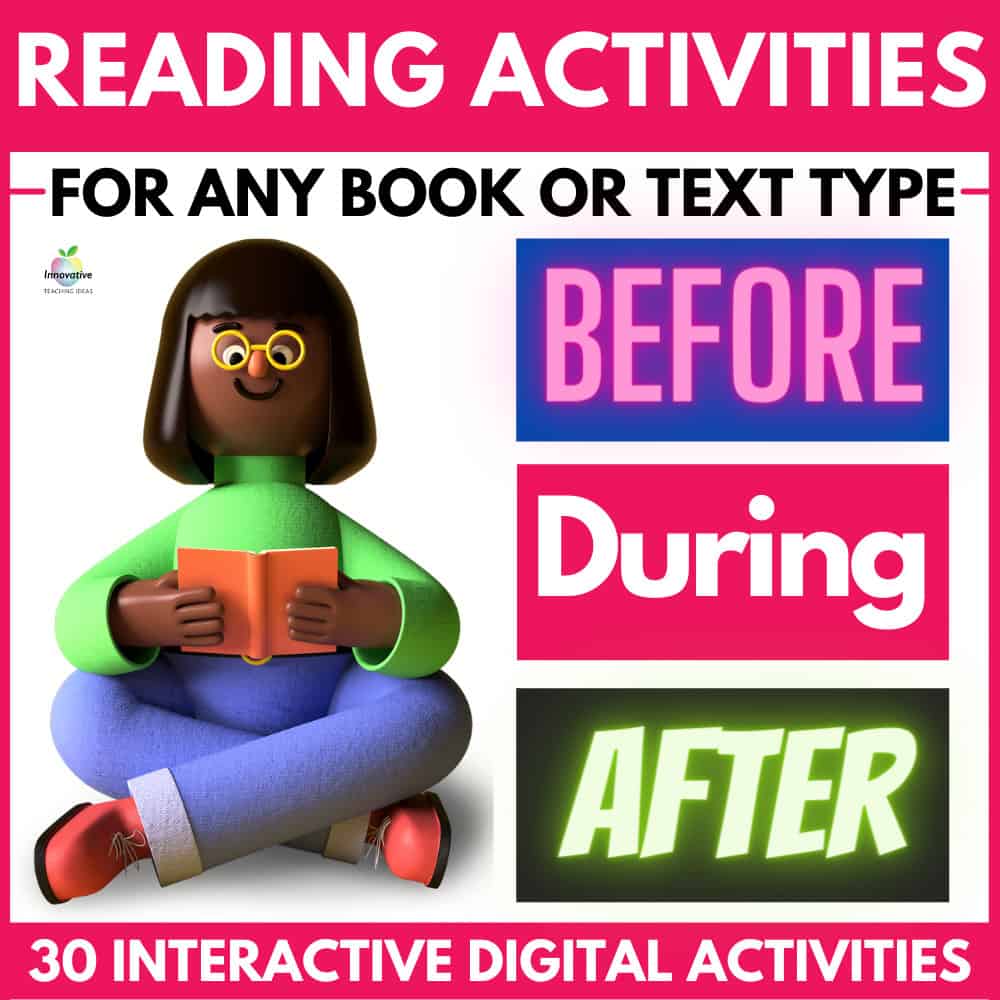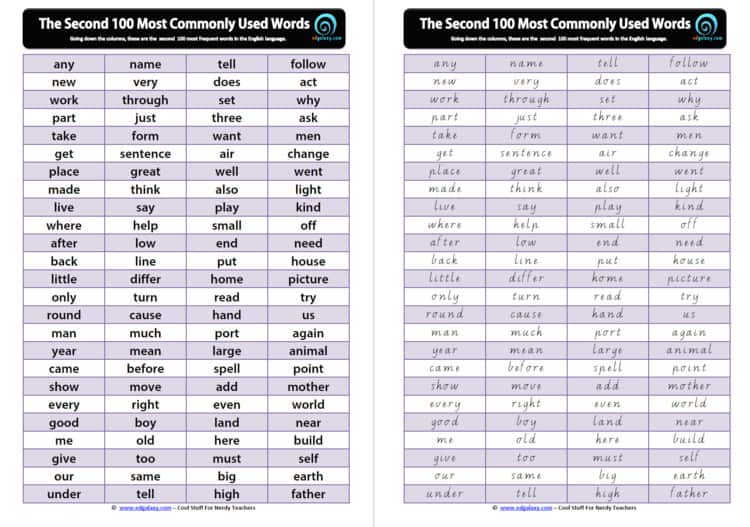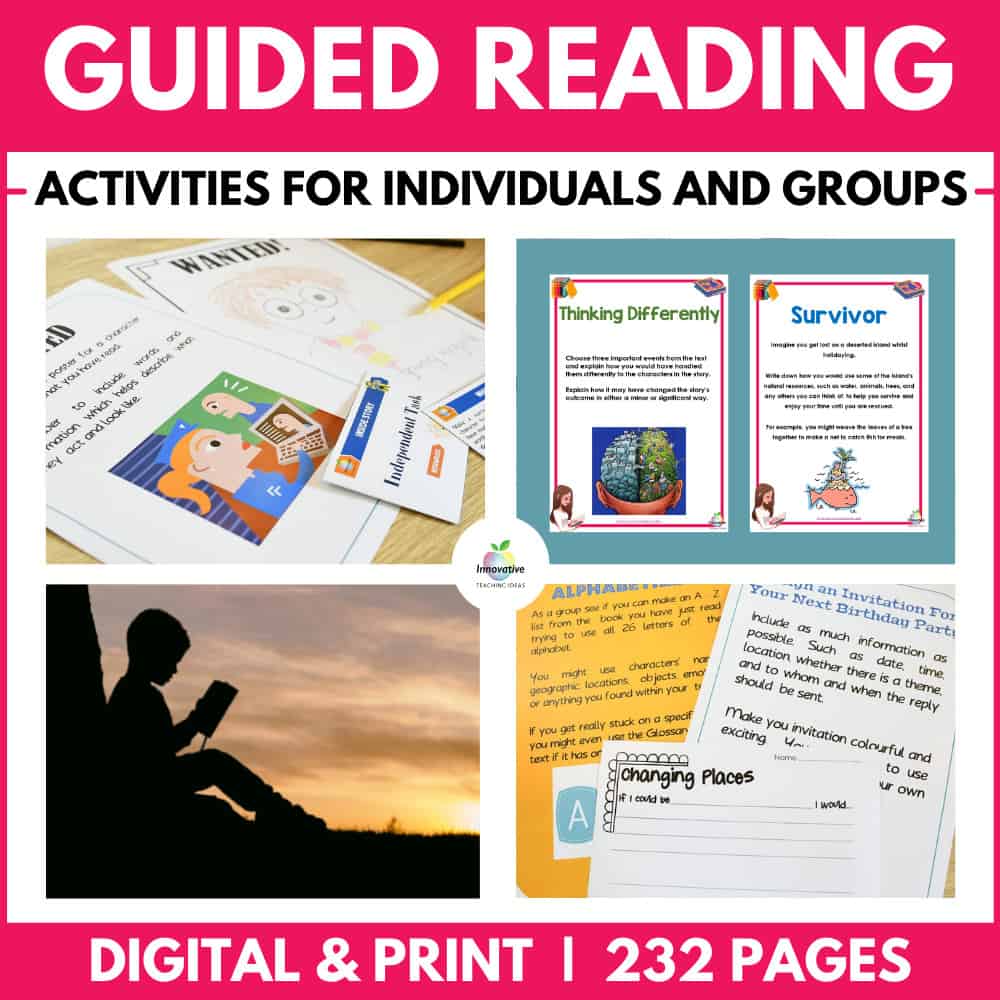

Throughout this article, I aim to provide you with a clear understanding of teaching phonics effectively in the classroom and offer a variety of strategies and proven ideas to teach phonics.
Phonics can be defined as a body of knowledge and skills regarding how the alphabet works.
In the context of this article, phonics refers to the method of teaching a student to read by developing their phonemic awareness and an understanding of the links between these sounds and how we use the letters of the alphabet to represent them.
This understanding is essential not only to read well but to bridge the gap between reading and writing.
With a good foundation of phonics knowledge, students can quickly become confident readers and independent solid writers.
When students develop phonemic awareness, it dramatically enhances their reading fluency which is a reading “superpower”, allowing students to read with speed, accuracy and expression. Reading fluency dramatically enhances students’ ability to read with intonation and energy that translates into expressive writing skills.

Over 30 engaging activities for students to complete BEFORE, DURING and AFTER reading ANY BOOK

The use of phonics, or synthetic phonics as this method is technically known, is an effective and efficient means of teaching young students how to read. For this reason, phonics is the primary methodology for teaching reading in the school systems of many English-speaking countries.
In English, there are around 44 sounds or phonemes. Given that there are only 26 letters used in the language and that many sounds have more than one possible spelling, it is helpful that students learn the relationships between the letters and sounds in a straightforward and explicit manner.
To achieve this, phonics centers on the relationship between sounds and how they can be spelled.
It focuses on the letter and sound correspondences to enable students to break written words down into their component sounds before later recombining them to read the whole word. This process is known as segmenting and blending.
Rather than allowing students to struggle to recognize complete words, as in the whole word method, or to look for contextual clues to figure out what is being said in a text, phonics teaches students to look at the letters of a word and segment it into its component sounds, before blending these sounds back together to read the entire word.
For example, when faced with the word cat, a student might run their finger under the first letter and make the initial /k/ sound, then /a/, and, finally, /t/.
Once they have successfully segmented these individual sounds, they then blend them together to say the word /kat/.
With practice, the speed with which students can look at a word, segment the sounds, and then blend these sounds together to read the word rapidly increases. This makes learning to read through the phonics method the most efficient way for most children to learn not just to read but to write too.

Initially, phonics reaps rich rewards for students in terms of the passive skill of reading. This is also known as decoding.
Later, the student’s knowledge of phonics can help them develop the active skill of writing or encoding.
For this reason, teachers will often weave emergent writing skills, such as letter formation, into their phonics lessons to take advantage of the opportunity to bridge this gap between reading and writing skills.
As effective as synthetic phonics are in teaching students to read, they won’t be enough on their own to unravel all the opaque mysteries of English orthography.
English is something of a mongrel language. Over the centuries, it has been influenced by the German, Latin, French, Greek, and Celtic languages, among others.
This fact has led to many inconsistencies in spelling surviving in the modern language. Sometimes phonics won’t be enough to decode these words. That’s why students need to learn to read some words by sight alone.
Sight words, or high-frequency words as they are also known, are those extremely common words used time and again in most texts. Many of them are phonetically irregular and follow no conventional spelling rules. For children’s reading books, sight words can account for up to 75% of the words in the text.
Therefore, it’s best to combine the study of phonics with the learning of these sight words for maximum effectiveness. This is something to consider when engaged in your long-term planning.
The most effective strategy for learning these sight words is for discussion another day; for the remainder of this article, we will focus exclusively on the teaching of phonics.


Before beginning to teach phonics, it is helpful to have a broad overview of the various stages that comprise a comprehensive synthetic phonics program. The following outline can serve as a practical general guide.
Before beginning to learn phonics in earnest (e.g. sound/letter correspondences), certain prerequisite skills need to be developed, including:
Children must be able to listen carefully to the sounds of speech. They must learn to filter speech sounds from other unrelated environmental sounds. This is usually best achieved by playing various listening games. When children have developed good aural comprehension, the game Simon Says is a fun way to further develop listening skills.
Once the children have learned to discriminate between various sounds, they should learn to reproduce these themselves. This is usually achieved by modelling the sounds carefully for the children and encouraging them to copy these with particular attention paid to the shape of the mouth when making each sound. The popular fun game Telephone is excellent for this.
It is essential for children learning to read to be able to sequence not only the events of a story but the individual sounds of the words they hear. They must be able to recognize which sound comes before or after another. They should also be familiar with sequencing language such as first, second, before, after, then etc.

Explicitly teaching the letter and sound correspondences lie at the heart of good phonics teaching.
It is essential to understand a little of the theory of synthetic phonics to be effective here. Here are a few important points to consider:
● Letter Names vs. Letter Sounds
It is crucial that children understand the difference between the names of the letters of the English alphabet and the sounds, as these are two very different things. For example, the letter c is called /see/ but the letter itself usually denotes either a /k/ or /s/ sound. It may seem obvious, but many teachers not trained in the teaching of phonics overlook this distinction and unwittingly make learning to read much more difficult for their students as a result.
● Letters Don’t Make The Sounds
As the limited letters used in English are needed to represent many different sounds, it’s important to point out to students that letters don’t make the sounds; they are simply an option for showing the sound. Often there will be more than one way to show the same sound; for example, the sound /s/ can be encoded in several different ways, including as s, c, and ps. When you are asking your students to write something, you can make the sound and ask them what letter they could use to show this sound. This type of phrasing reinforces the correct relationship between the letters and sounds.
● Avoid The Lazy Vowels
It is also important to remember that when teaching the letters and sounds to avoid making the lazy vowel or schwa sound at the end of a sound. For example, when pronouncing the /k/ sound, make it crisp and short, rather than adding in an extra -uh sound at the end. This will make it much easier for the students to blend sounds together later.

The detail and delivery of your phonics lessons will depend greatly on the specific situation of your students. However, some general points will be helpful to consider when planning a phonics lesson for your class.
● Keep Phonics Lessons Short and Sweet
To avoid getting bogged down and boring your kids, keep phonics lessons short. In and around 10 to 15 minutes is ideal and no more than 20 minutes. Remember, we want our kids to be lifelong readers, and that means they need to enjoy it!
● Be Consistent
There is a lot of ground to cover here, and consistency is key. If your students are learning to read, they’ll need to practice and study their phonics every day – preferably at the same time each day too.
● Keep on Moving
While a lot of reinforcement will be required over the course of the year, research has shown that keeping a brisk pace through a phonics program achieves the best results. Don’t get bogged down waiting for everyone to get everything before moving on. You will be revisiting the material.
● Keep Things Fun!
Learning to read should be a positive experience, particularly as learning to read means acquiring one of the most empowering skills a child will ever have. To keep things fun, be sure to incorporate lots of enjoyable activities and games into your phonics lessons.

Ensure your students are constantly engaged with these INDEPENDENT & GROUP Reading Activities for ANY BOOK.
I Spy
This perennial classic is a fun way to get some phonics practice in. You can adapt it to say, “I spy with my little eye something beginning with…” and say a sound rather than a letter. If you wish to work on letter recognition rather than sound, simply hold up the letter itself quietly.
Sorting Activities
Sorting activities are a great way for students to practice their phonics knowledge and can take on an almost infinite number of variations. For example, younger kids may enjoy sorting objects into two hula hoops on the floor, which are labelled with their initial consonant sounds, while older kids might work on consonant blends.
Bingo
Bingo is another very versatile game that can be used to practice sound and letter recognition. Simply decide what you want to work on and place those into suitably sized grids (9×9 works well). These could be initial consonants, vowel digraphs, or pictures of nouns. If you set up some blank grids on laminated sheets, you can save yourself a lot of prep time too. Simply write a broad selection of sounds you are working on onto the whiteboard. Students can select 9 of them to fill in their laminated grid. Now each student will have their own unique bingo card!
Partner Reading
Partner reading is a great way to practice listening skills, as well as reading. Organize students into pairs and provide them each with a copy of the same text. One partner reads the text while the other follows closely with their own copy. The listening partner helps the reader decode difficult words when they have trouble. After a time, partners switch roles. This usually works best when partners are of a similar ability. You can further differentiate here by choosing different texts to suit the abilities of each pair.
Shared Writing
Shared writing is an effective means of introducing independent writing activities. For beginning students, it may take the form of simply spelling a basic CVC word together. For example, to work on the spelling of the word cat, you could draw three cradles on the whiteboard and say each sound; in turn, challenge the students to come up and write the corresponding letter in the cradle until they have written the word C – a – t.
As we can see, the teaching of phonics is a highly efficient and effective means of teaching our children to read and, ultimately, write. It works on training students to be able to hear the various sounds of English, identify these sounds, and link these sounds to the symbols we call letters.
While there are other methods of learning to read employed with emergent readers in the classroom, in two decades of teaching, I’ve never seen another methodology come anywhere close to phonics for overall effectiveness.
And, best of all, phonics can be a lot of fun to learn and teach too!